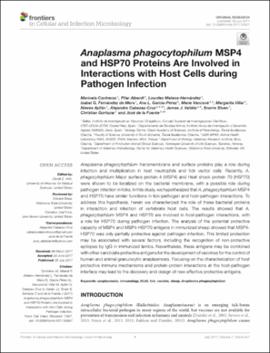| dc.contributor.author | Contreras, Marinela | |
| dc.contributor.author | Alberdi, Pilar | |
| dc.contributor.author | Mateos-Hernandez, Lourdes | |
| dc.contributor.author | Fernandez de Mera, Isabel G. | |
| dc.contributor.author | Garcia-Perez, Ana L. | |
| dc.contributor.author | Vancova, Marie | |
| dc.contributor.author | Villar, Margarita | |
| dc.contributor.author | Ayllon, Nieves | |
| dc.contributor.author | Cabezas-Cruz, Alejandro | |
| dc.contributor.author | Valdes, James J. | |
| dc.contributor.author | Stuen, Snorre | |
| dc.contributor.author | Gortazar, Christian | |
| dc.contributor.author | de la Fuente, Jose | |
| dc.date.accessioned | 2019-08-28T16:00:59Z | |
| dc.date.available | 2019-08-28T16:00:59Z | |
| dc.date.issued | 2017-07-05 | |
| dc.identifier | oksd_contreras_anaplasmaphagoc_2017 | |
| dc.identifier.citation | Contreras, M., Alberdi, P., Mateos-Hernandez, L., Fernandez de Mera, I. G., Garcia-Perez, A. L., Vancova, M., ... de la Fuente, J. (2017). Anaplasma phagocytophilum MSP4 and HSP70 proteins are involved in interactions with host cells during pathogen infection. Frontiers in Cellular and Infection Microbiology, 7, Article 307. https://doi.org/10.3389/fcimb.2017.00307 | |
| dc.identifier.uri | https://hdl.handle.net/11244/321397 | |
| dc.description.abstract | Anaplasma phagocytophilum transmembrane and surface proteins play a role during infection and multiplication in host neutrophils and tick vector cells. Recently, A. phagocytophilum Major surface protein 4 (MSP4) and Heat shock protein 70 (HSP70) were shown to be localized on the bacterial membrane, with a possible role during pathogen infection in ticks. In this study, we hypothesized that A. phagocytophilum MSP4 and HSP70 have similar functions in tick-pathogen and host-pathogen interactions. To address this hypothesis, herein we characterized the role of these bacterial proteins in interaction and infection of vertebrate host cells. The results showed that A. phagocytophilum MSP4 and HSP70 are involved in host-pathogen interactions, with a role for HSP70 during pathogen infection. The analysis of the potential protective capacity of MSP4 and MSP4-HSP70 antigens in immunized sheep showed that MSP4-HSP70 was only partially protective against pathogen infection. This limited protection may be associated with several factors, including the recognition of non-protective epitopes by IgG in immunized lambs. Nevertheless, these antigens may be combined with other candidate protective antigens for the development of vaccines for the control of human and animal granulocytic anaplasmosis. Focusing on the characterization of host protective immune mechanisms and protein-protein interactions at the host-pathogen interface may lead to the discovery and design of new effective protective antigens. | |
| dc.format | application/pdf | |
| dc.language | en_US | |
| dc.publisher | Frontiers Media | |
| dc.rights | This material has been previously published. In the Oklahoma State University Library's institutional repository this version is made available through the open access principles and the terms of agreement/consent between the author(s) and the publisher. The permission policy on the use, reproduction or distribution of the material falls under fair use for educational, scholarship, and research purposes. Contact Digital Resources and Discovery Services at lib-dls@okstate.edu or 405-744-9161 for further information. | |
| dc.title | Anaplasma phagocytophilum MSP4 and HSP70 proteins are involved in interactions with host cells during pathogen infection | |
| osu.filename | oksd_contreras_anaplasmaphagoc_2017.pdf | |
| dc.description.peerreview | Peer reviewed | |
| dc.identifier.doi | 10.3389/fcimb.2017.00307 | |
| dc.description.department | Veterinary Pathobiology | |
| dc.type.genre | Article | |
| dc.type.material | Text | |
| dc.subject.keywords | anaplasma phagocytophilum | |
| dc.subject.keywords | hl60 | |
| dc.subject.keywords | anaplasmosis | |
| dc.subject.keywords | immunology | |
| dc.subject.keywords | sheep | |
| dc.subject.keywords | tick | |
| dc.subject.keywords | vaccine | |
